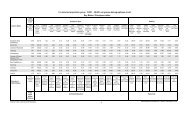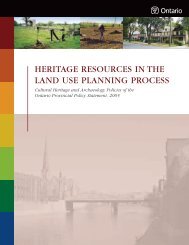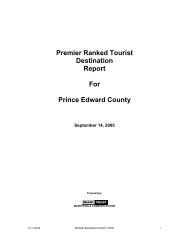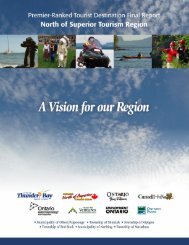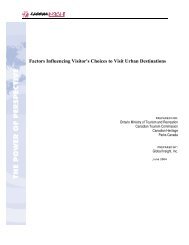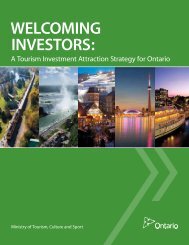Management Guidelines For Forestry and Resource-Based Tourism
Management Guidelines For Forestry and Resource-Based Tourism
Management Guidelines For Forestry and Resource-Based Tourism
- No tags were found...
You also want an ePaper? Increase the reach of your titles
YUMPU automatically turns print PDFs into web optimized ePapers that Google loves.
<strong>Management</strong> <strong>Guidelines</strong> for <strong>For</strong>estry <strong>and</strong> <strong>Resource</strong>-<strong>Based</strong> <strong>Tourism</strong> – TOOLS AND TECHNIQUESationist may hear forestry operations. <strong>For</strong>estry operationshave changed in some parts of the forest whereequipment may operate "round the clock", or for "twoshifts;" these operations may require special attention.<strong>For</strong>estry operations may be scheduled to those timeswhen tourists are not likely to hear the noise.<strong>For</strong>estry operations, in an area, may be planned to takeplace as swiftly as possible <strong>and</strong> then leave the area forthe remainder of the forest’s cycle. In some cases theremay be advantages to limiting the number of pieces offorestry equipment operating at any one time toreduce the overall noise level in the vicinity of aresource-based tourism value; although this will extendthe period of noise.It may be possible to rotate the use of outpost campsso that those closest to forestry operations receive littleor no use for one or two seasons. Consider the "floating"outpost concept. Where an operator does not have theability to rotate camps, he may be allowed to temporarilyincrease the beds in other camps while noiseis a problem.Road building operations can create excessive noise.In some cases it is the banging of dump truck tailgates,which causes the offensive noise. There may be measuresthat can be taken to reduce this type of noise.Processing wood by chipping or cutting to length witha "slasher" can be noisy practices. Distance betweenthe camp <strong>and</strong> operations, is a consideration to minimisethe impact of noise during peak resource-basedtourism use periods. All forestry machinery should bein good working order <strong>and</strong> properly muffled.Pros <strong>and</strong> Cons for the <strong>Resource</strong>-based <strong>Tourism</strong>IndustryPros• Noise is mostly a short term problemCons• Guests that hear noise may complain <strong>and</strong>,may not returnPros <strong>and</strong> Cons for the <strong>For</strong>est IndustryPros• NoneCons• As per section 3.3.5, only planning winter operationsfor the forest near resource-based tourismareas is impractical unless operational <strong>and</strong> renewalconstraints permit. (on some forests, all areas haveresource-based tourism concerns).3.7 PlanningDescriptionManaging the resource-based tourism/forestry interfaceis a critical part of forest management planning.The designation of remote, semi-remote, <strong>and</strong> drive-inis made very early in the planning process. Once thisdesignation is established the planner <strong>and</strong> the planningteam will consider the location of access, harvestblocks, access removal <strong>and</strong> other impacts on theresource-based tourism industry during the developmentof a road use management strategy.Once the criteria for selecting st<strong>and</strong>s for harvest havebeen finalized <strong>and</strong> areas of operation become clear,resource-based tourism prescriptions become lessgeneral <strong>and</strong> more site specific. It is during this stagefor example, that potential road access is determined<strong>and</strong> that potential physical access controls are determined<strong>and</strong> regulatory prescriptions are recommended.Loop roadsThe use of tertiary loop roads has been questioned wherethey are planned adjacent to resource-based tourism values.In fact, this practice is neither "good" nor "bad"when addressing resource-based tourism values. The goalof access management is to diminish opportunities forunplanned access. During individual consultationsbetween the planner <strong>and</strong> the tourist operator, specificlocations of concern to the operator are identified, <strong>and</strong>within the constraints of the specific topography, theactual locations for roads are determined.Roads which parallel the valueThe same (see Loop Roads) is true for roads whichparallel the value to be protected (e.g. lake or river).Sometimes a parallel road is not a good idea; at othertimes it makes more sense. The goal is to identifyareas which are likely to encourage unplanned access<strong>and</strong> avoid them wherever possible. If this is not possible,then plan ahead to use the tools <strong>and</strong> techniquesdescribed in section 3.3 to stop unplanned access.23



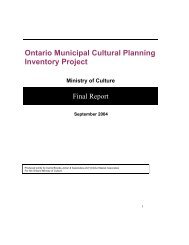
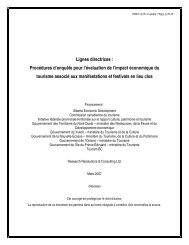
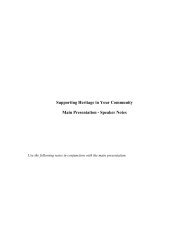
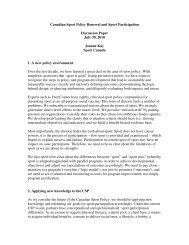
![THIS AGREEMENT made this [date], between [name of owner] (the ...](https://img.yumpu.com/49827605/1/158x260/this-agreement-made-this-date-between-name-of-owner-the-.jpg?quality=85)

